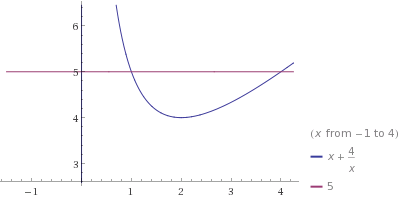Science:Math Exam Resources/Courses/MATH101/April 2008/Question 02 (c)/Solution 2
The first step to solve this problem is to understand what volume we are trying to compute.
The question states that there is a region delimited by the curves y=5 and y=x+4/x. The second curve looks like the line y=x except that there is a vertical asymptote at x=0. So it seems that it will indeed cross the horizontal line y=5 twice (as it dips down before going back up). We can compute where the intersections are by solving:
which is equivalent to
and has solutions x=1 and x=4. Then we want to know how far down the curve goes, so we look for its local minimum. We compute its derivative:
and hence see that it has two critical points, one at x=-2 and one at x=2. We are only interested in the local minimum which is at x=2. This should be enough details to have you be able to obtain the equivalent of the following picture:
Now we want to rotate this region around the vertical axis x=-1. To do this, we will use the method know as disk integration. The idea is fairly simple: imagine the solid viewed from the top (looking down at the axis), if we slice it along that axis, we will see a slice of a hollow cylinder. We will compute the area of that slice (the difference of area between the outer disk and the inner disk) and integrate.
The outer disc has a radius that starts at the point (2,4) and moves right towards the point (4,5) following the curve y=x+4/x. The inner disc has a radius that starts at the point (2,4) and moves left towards the point (1,5) following the other side of the curve. We need to compute that radius (starting at x=-1). For this, the first step is to express the curve in terms of y instead of x:
If we look at this, it makes sense: This is only well defined if y is larger than 4 (see on the graph) and there are two components: the one with the + for the right side and the one with the - for the left side. Since the axis of rotation is at x=-1, we need to add 1 to each of the radius and obtain:
And so we can write the volume by integrating over all the shells, which are obtained by taking the difference of the outer and inner disk:
(since the area of a disk of radius r is r2).
Now we can do some algebra to rewrite this integral into something easier to handle. Notice the pattern here
Hence we can rewrite this as
Now we need to compute that integral to obtain the desired volume. Unfortunately, this won't be straightforward since (2+y) isn't a multiple of the derivative of what is in the square root. There are many ways to compute this integral, here we will split it in 2 and deal with each term.
Let us call the first integral V1 and the second one V2. The first one is the tougher one. Indeed:
The first integral is actually quite complicated. At the same time it is a classic. As of today (2012) you are not expected to be able to integrate this by hand and/or know the formula from memory. For completion sake, here is the formula:
Which in this case gives us:
Summing gives which is the same as above.
... This is why using the correct method of solids of revolution is very important.











![{\displaystyle {\begin{aligned}V_{2}&=\pi \int _{4}^{5}y{\sqrt {y^{2}-16}}\,dy\\&={\frac {\pi }{2}}\int _{4}^{5}2y{\sqrt {y^{2}-16}}\,dy\\&={\frac {\pi }{2}}\left[{\frac {2}{3}}(y^{2}-16)^{3/2}\right]_{4}^{5}\\&={\frac {\pi }{2}}{\frac {2}{3}}(25-16)^{3/2}\\&={\frac {\pi }{3}}\cdot 27\\&=9\pi \end{aligned}}}](https://wiki.ubc.ca/api/rest_v1/media/math/render/svg/5ffd779fb46f53efeb20e4ac916f512571680049)

![{\displaystyle {\begin{aligned}V_{1}&=\pi \int _{4}^{5}2{\sqrt {y^{2}-16}}\,dy\\&=2\pi \left[{\frac {y}{2}}{\sqrt {y^{2}-16}}-8\ln(y+{\sqrt {y^{2}-16}})\right]_{4}^{5}\\&=2\pi \left[({\frac {5}{2}}{\sqrt {9}}-8\ln(5+{\sqrt {9}})-(0-8\ln(4+0))\right]\\&=2\pi ({\frac {15}{2}}-8\ln(8)+8\ln(4)\\&=\pi (15-48\ln(2)+32\ln(2))\\&=\pi (15-16\ln(2))\end{aligned}}}](https://wiki.ubc.ca/api/rest_v1/media/math/render/svg/00599d925d5548fee69cfabeef226e575aceae5b)

